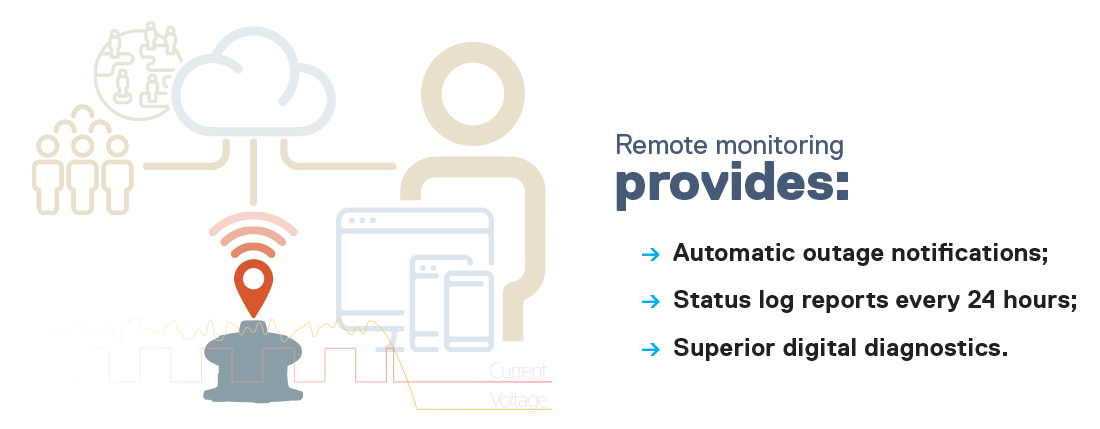Responsible Obstruction Light Monitoring
has the responsibility
of knowing the status
of their critical lighting
infrastructure and
maintaining its
correct operation…
Safety and Community Responsibility.
Lives are at risk every time obstruction lighting systems are not functioning properly. Whether it be from impaired visibility for nearby air traffic or light outages that require technician intervention, the structure owner has the responsibility of knowing the status of their critical lighting infrastructure and maintaining its correct operation so that near misses and possible fatalities are avoided.
Unfortunately, many of these structures are not in conformance with the federally mandated monitoring requirements to ensure proper operational awareness. According to the Occupational Safety and Health Administration (OSHA) reporting, there were 32 U.S. tower related fatalities recorded in the last five years alone.
are reliable, simple to use;
and offer a wide variety of
remote interface capabilities
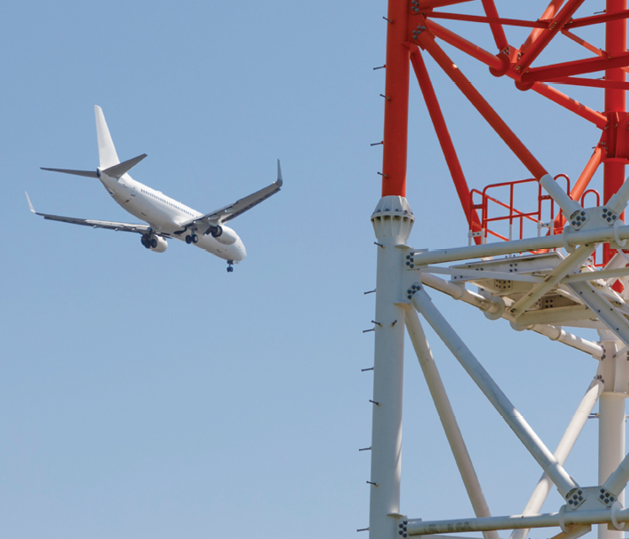
FAA Advisory Circular AC 70/7460-1M, Section 4.7 states that all obstruction lighting systems must be monitored either via a manual visual check once every 24-hours, or via a smart monitoring system.
Such systems must provide an accurate status on the lights operation, regardless of the position or color, and via a remote connection to an operations center that would address any malfunction detected with the obstruction lighting system.
While the manual visual operation can be unreliable and difficult to carry out in circumstances like adverse weather, intelligent monitoring systems are reliable, simple to use, and offer a wide variety of remote interface capabilities. Modern devices employ cellular or Ethernet connectivity utilizing several data platforms including Simple Network Management Protocol (SNMP).
For owners who maintain more than one structure to monitor, an SNMP connection provides an easy and flexible way to organize multiple assets across a single network.
While FAA lighting standards are considered advisory in nature, Federal Communications Commission (FCC) Code of Federal Regulations (CFR) 47 Section 17.21-17.58 makes these standards mandatory for structure owners.
Lighting configurations are assessed with an aeronautical study. They are assigned based on each structure’s registration through the FAA’s “determination of no hazard” process. The FCC has specified stringent penalties for non-compliance up to and including monetary forfeitures.
In the past 10 years, the FCC’s Enforcement Bureau imposed penalties totaling over $365 million dollars to telecom carriers and structure owners. The continued crack-down by the FCC has resulted in safer air navigation space and higher levels of site compliance.
On August, 2018 a small plane crashed into a 1,800’ television tower in Kaplan, LA, and fatally injured both occupants.
An FCC investigation found several issues related to improper tower light monitoring and record keeping across multiple towers owned by the broadcaster, resulting in a civil penalty settlement of over $1 million dollars.
The FCC can also assess individual financial penalties that range from $1,000 to several million dollars, depending on the severity of the infraction, involving the owner’s compliance history with the FCC and/or the number of structures involved.
were reduced by almost
six million dollars
in the first year.
According to Code of Regulations (CFR) 47 Section 17.47(b) the structure owner must inspect the lighting equipment at least once every three months, a process also known as quarterly lighting inspections. However, as of August 8, 2014 an owner who implements a qualified monitoring system can apply for a waiver which permits an exemption from this rule. Removing the requirement for a physical check of the system every three months leads to immediate financial savings.
The owner is simply required to deploy a monitoring system with robust self-diagnostic functions that monitors the operation of all systems on the structure. The change was made following an extensive study that characterized the efficacy of automated monitoring systems.
The Wireless Telecommunications Bureau concluded that automated data-driven monitoring systems could replace quarterly visits without any detriment to safety.
Before the exemption rule, an ALI waiver program was put into place starting in 2005. The ALI waiver study, in partnership with a U.S. based Real Estate Investment Trust (REIT) Company that operates a large wireless and broadband communications network, found operational expenditures were reduced by almost six million dollars in the first year. While this study involved an owner with approximately eight-thousand illuminated structures, owners with smaller portfolios can similarly realize significant savings with a small Capex investment for automated monitoring systems. Starting in 2008 Global Tower was granted an ALI waiver that has substantially reduced their operating and labor costs. The adoption of the exemption rule in 2014 has provided a higher level of financial savings while maintaining safety for the nearby airspace.
While traditional monitoring methods, like dry contact alarms or tower watchers are compliant solutions, data-driven monitoring has been proven to be more reliable in the field. Dry contacts use wired connections through a low voltage alarm relay to produce alarm notifications. However, these legacy connections regularly fail due to loose wiring, secondary system repairs, environmental conditions and most commonly wildlife such as rats, mice and squirrels.
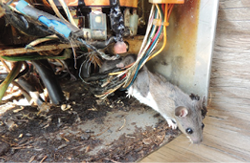
Sites monitored via a normally open (alarm on closed) dry contact connections could never produce an alarm notification. In this state, a relay is energized when an alarm condition presents itself. When energized, a low voltage signal is sent across the alarm wire circuit.
However, if a single alarm wire is damaged or disconnected, the voltage loop is unable to complete, and thus an alarm notification is not generated. This is a dangerous position for structure owners to find themselves in. Data monitoring provides intelligent fail-safes to notify the user if the status of the lighting system is unknown, all while removing the human and environmental elements that can cause improper monitoring.
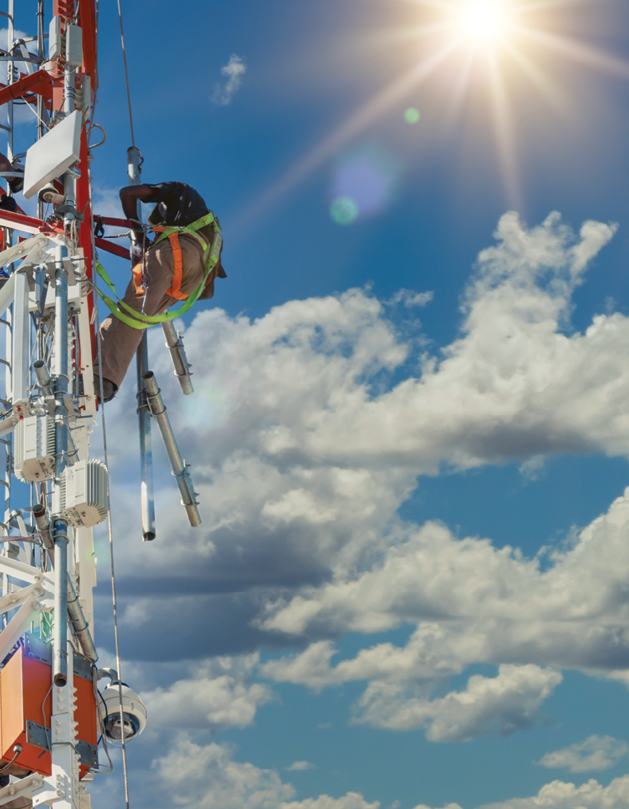
There are generally two defined categories for lighting alarms – major and minor. Major alarms require NOTAM (Notice to Air Missions) reporting. Minor alarms must be corrected as soon as possible, but notifying the local flight service station is not required.
Major Alarms Explained
(NOTAM)
Beacon/Strobe Failure
The red and/or white flashing light is not operating to FAA standards.
Beacon/Strobe Communication Failure
The red and/or white flashing light is not communicating with the system controller.
Low Flash Energy
The red and/or white flashing light visible intensity (brightness) does not meet FAA standards since it is not bright enough to be seen by pilots in the area.
Consecutive Missed Flashes
The red and/or white flashing light visible intensity (brightness) does not meet FAA standards since it is not bright enough to be seen by pilots in the area.
Flashing Side Marker Failure
Three or more consecutive missed flashes is considered an improperly functioning light.
Mainly found with tube-based technology.
Photocell Failure
The red flashing L-810 side light is not operating to FAA standards.
Power Failure
The external mode control device, that provides automatic changes to the system’s output intensity and color, is not operating to FAA standards.
Site Communication Failure
Incoming/grid power outage. Not typically NOTAM worthy if caused by passing weather patterns. If power restores within 30 minutes a NOTAM is not required.
Beacon/Strobe Failure
When the site lighting status cannot be verified remotely. Generally occurs with cellular technology in poor weather conditions. If communication restores within 30 minutes, a NOTAM is not needed.
Minor Alarms Explained
(Non-NOTAM)
Side Marker Failure
The red steady-burning L-810 side light is not operating to FAA standards.
AC/Generator Backup Power Failure
AC backup power is unavailable.
DC Backup Power Failure
DC backup power is unavailable.
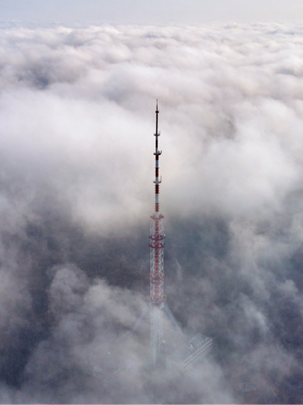

Per FCC rules, each structure must maintain a log that records the lighting system’s daily operational status. Logs must include dates and times of outages and improper operation, as well as detailed notes about the nature of the repairs made to restore the lighting system to FAA standards.
a Failure
The FCC requires notification of an outage or improperly functioning light within 30 minutes of the failure. If normal operation of the lighting system cannot be achieved within 30 minutes a Notice to Air Missions (NOTAM) must be recorded with the nearest flight service station. NOTAMs are issued via telephone or digitally through the FAA ENII System.
Note: Light fixture lenses should be visually inspected every 24 months or when ultraviolet (UV) damage, cracks, crazing, dirt buildup, etc. inhibit the certified light output. Lenses that have cracks, UV damage, crazing, or excessive dirt buildup should be cleaned or replaced.

Modern-day National Operations Centers National Operations Centers (NOC) employ data verification procedures, to ensure FAA databases match tower filings. This streamlines the NOTAM issuance process. Automated systems create intelligent rules to eliminate unnecessary truck roll costs and reduce the number of false and redundant alarms, like system power resets.
An FCC investigation found several issues related to improper tower light monitoring and record keeping across multiple towers owned by the broadcaster, resulting in a civil penalty settlement of over $1 million dollars.
Modern-day National Operations Centers (NOC) employ data verification procedures, to ensure FAA databases match tower filings. This streamlines the NOTAM issuance process. Automated systems create intelligent rules to eliminate unnecessary truck roll costs and reduce the number of false and redundant alarms, like system power resets.
Pre-site visit diagnostics are encouraged. Reviewing monitoring data from the site allows site managers and technicians to determine if a NOTAM or truck-roll is needed and what spare parts to carry with them to complete a repair. Site managers can also perform preventative maintenance tasks during these site visits, leading to reduced truck rolls and operational savings.
In the event of a site incident or investigation, NOCs are easily able to provide detailed repair logs and event history to show the structure lighting was working at the time of the incident or identified as a NOTAM outage to the appropriate flight service station.
Each monitored location is queried at least once every 24 hours to verify operational status and record diagnostic logs.



